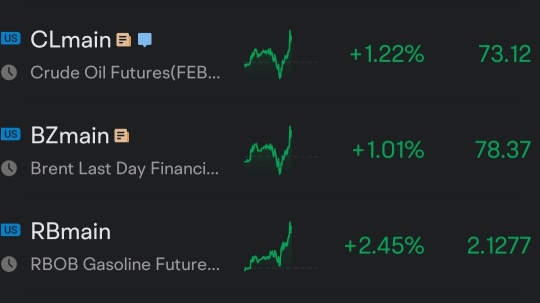No Data
No Data
Oil Gains on Trump's Announcement of 90-Day Pause on Higher U.S. Tariffs -- Market Talk
Oil Prices Surge 4% After Trump Pauses Tariffs For Most Countries
Last week, the USA's Crude Oil Product inventory increased while the RBOB Gasoline and refined oil inventories declined.
The US Energy Information Administration announced this Wednesday that as of the week ending April 4, US Crude Oil Product inventories have increased.
Continuously falling! The new round of tariffs scares the oil market, and international oil prices have dropped by 4%.
International oil prices continue to decline significantly, dropping to their lowest point in four years.
Closing Bell Movers: Futures Extend Selloff as Midnight Tariff Deadline Looms
Investors are making a large-scale exit from the Crude Oil Product Put Fund, resulting in the largest outflow of funds since 2020.
An exchange-traded fund (ETF) linked to the decline of the crude oil market has just experienced the largest outflow of funds since 2020.












BelleWeather : I think proper portfolio positioning vis a vis inflation is important. The concern I have is stagflation, so I’m trying to be defensive to that. This is difficult. And timing the market is impossible and crazy-making, so I personally am taking each day as it comes.
I don’t think anyone is going to sell off over these concerns, and Powell is not about to fan those flames either!
SpyderCall OP BelleWeather : They might not sell over these concerns. But when these variables are present, then any negative catalyst will likely catalyze a selloff. For example, if we get bad rhetoric from Powell next week, then we might see extra volatility. That being said, in the current environment, any selloff will be a good buying opportunity until something breaks in the economy.
SpyderCall OP BelleWeather : So far, wages and employment numbers have held up, so stagflation is not a concern until inflation picks back up. With the way oil and gasoline prices have been climbing, we could possibly see a stagflationary environment soon, but not yet. Things are almost perfect in the economic data currently. We are in a goldilocks zone for the Fed right now. And if things get worse, then the Fed has already mentioned cutting rates. That would be even more accomodative for equities as the "Fed Put" will be in play at that point. So, if we do see stagflation, it shouldn't last long as the Fed will accommodate markets when the inflation, wages, or employment situation changes negatively.
BelleWeather : Agreed on the Goldilocks zone vis a vis the Fed mandate save one issue - the reserve bank balance is almost out - won’t they have to move to correct that?
SpyderCall OP BelleWeather : They have been greatly decreasing the balance sheet since march 2022. This is done through selling treasury bonds or mortgage securities. Short-term treasuries, like bills, have been the biggest culprits for the runoff of the balance sheet. This has been unwinding the massive amount of asset purchases since the 2008 financial crisis.
They purchased all of these assets back then as a form of quantative easing to boost the economy. Right now, they are selling treasury notes at sky-high yields to provide liquidity to banks essentially. This is putting more liabilities onto the balance sheet, which brings the balance down.
I don't think the balance sheet runoff is such a big deal at the moment.
Once the economy is showing signs of trouble, then I think we will need to worry about the Fed balance sheet. If they start buying assets, essentially quantative easing, then they might think that there is weakness in the economy.
You might think that with the Fed balance falling like it is, then long-term treasuries should be falling along with the balance. But that has not been the case since last November as these treasuries have been climbing.
This tells me that the balance sheet is now falling because the Fed is adding liquidity through short-term bond sales, which inject liquidity into the economy, which is good for an economy and equities.
View more comments...